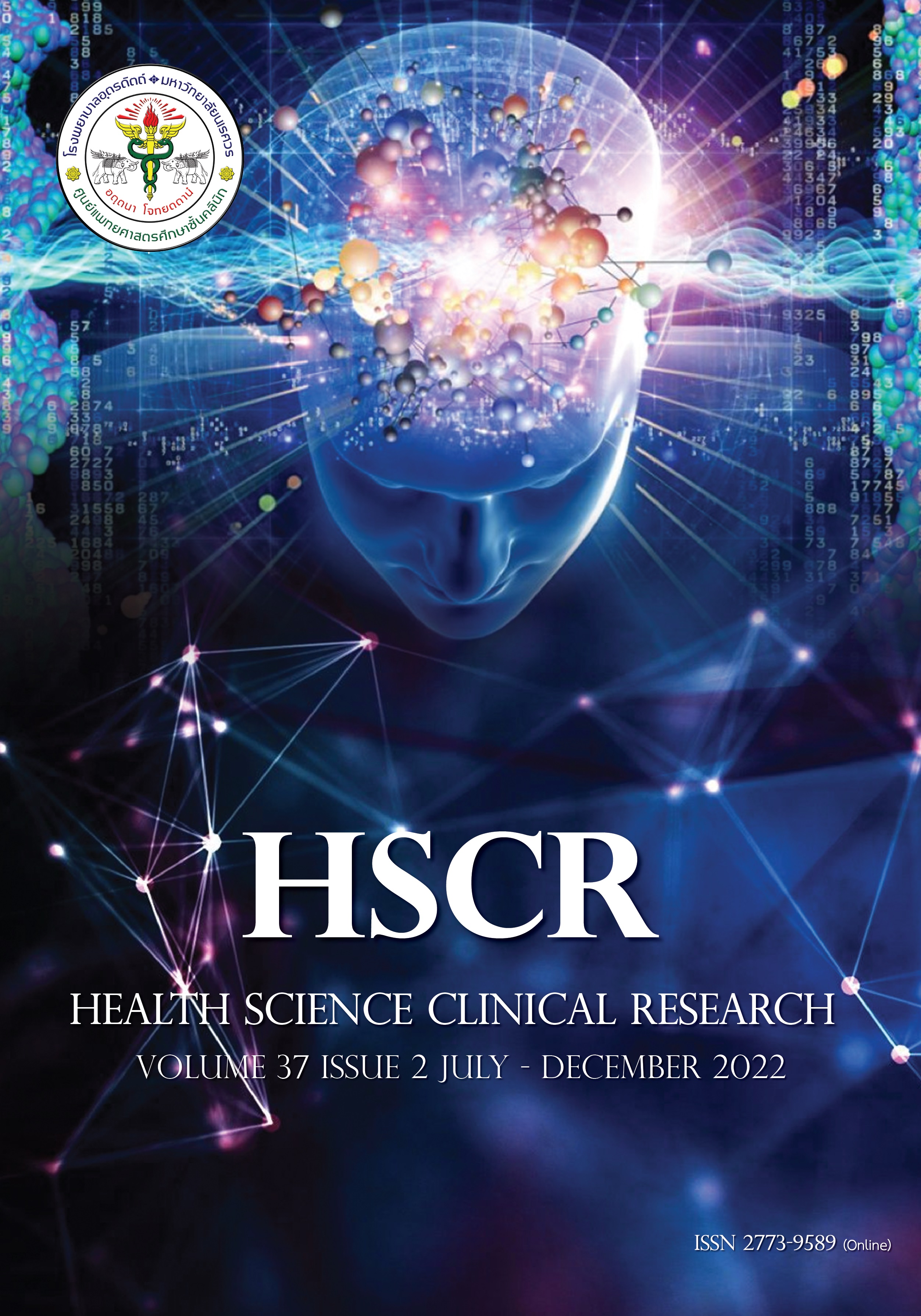Creation of Score System for Colon Cancer Screening and Prioritize of Colonoscopy in Uttaradit Hospital
DOI:
https://doi.org/10.1016/hscr.v37i2.257014Keywords:
colorectal cancer, scoring system, colorectal cancer screening, colonoscopyAbstract
ABSTRACT
Objective: To create a scoring system for colon cancer screening for prioritizing the urgency of colonoscopy and rectum at Uttaradit Hospital.
Methods: A retrospective cohort designs prognostic prediction research in people undergoing colonoscopy. Uttaradit Hospital has all cases between February 1, 2019, and February 28, 2021. Searched from medical records of outpatients and inpatients with operative code colonoscope. Related factors were studied, also analyze the factors that predict risk multivariable multinomial logistic
regression was also used to develop predictive scores. multivariable binary logistic regression
Results: 1,057 colonoscopy subjects were classified according to pathology into 3 groups: 319 diagnosed with colon cancer and malignant conditions, 288 benign conditions, and benign conditions. 450 normal colonoscopy found the factors predicting the risk of colon cancer were male, age >45 years, history of colonoscopy in 5 years, constipation alternating diarrhea, chronic diarrhea blood transfusion, and rectal pain such factors can be distinguished between colon cancer and other diseases. AuROC curve 87.1% (95%CI = 63.0,70.0) was used to create a risk score of 0-20.5 points, divided into 3 levels: low risk (<5.5 points), PPV 26.0 (95%CI=23.1,29.1), moderate risk. (5.5-8.5 points) PPV 44.9 (95%CI=37.6,52.3) and high risk (>8.5 points) PPV 86.7 (95%CI= 59.5, 98.3)
Conclusion: Colonoscopy participants rated at high-risk scores should have a colonoscopy first then medium-risk and low-risk, respectively, and the scoring system should be used to help screen for colon cancer in the general public.
Keywords: Colorectal cancer, scoring system, colorectal cancer screening, colonoscopy
References
World Health Organization. The international agency for research on cancer (IARC). Globocan 2012. Available at: URL: http://globocan.iarc.fr/Pages/fact_sheets_cancer.aspx. Accessed: August 14, 2014.
Terry MB. Risk Factors for Advanced Colorectal Adenomas: A Pooled Analysis. Cancer Epidemiology, Biomarkers & Prevention 2002, 11;622–9.
Siew CN and Sunny HW. Colorectal cancer screening in Asia. British Medical Bulletin Journal 2013; 105;29-42.
กันต์กมล กิจตรงศิริ. รายงานการวิจัย การศึกษาความคุ้มค่าของการตรวจคัดกรองมะเร็งลำ ไส้ใหญ่และไส้ตรงในประชากรไทย Economic evaluation of colorectal cancer screening among Thai population ภายใต้โครงการศึกษาเพื่อพัฒนาชุดสิทธิประโยชน์ภายใต้ระบบหลักประกันสุขภาพถ้วนหน้า 2555.
สำนักงานหลักประกันสุขภาพแห่งชาติ. [อินเตอร์เนต] [เข้าถึงเมื่อ 13 ธันวาคม 2564] เข้าถึงได้จาก: https://www.hitap.net/wp-content/uploads/2018/10/Full-report_CRC-screening.pdf
ณปภัช โพธิ์พรหม. การพัฒนาระบบคะแนนช่วยคัดกรองโรคมะเร็งลำ ไส้ใหญ่: ทางเลือกในการเข้าถึงบริการสุขภาพ. [วิทยานิพนธ์สาธารณสุขศาสตรมหาบัณฑิต]. ชลบุรี: มหาวิทยาลัยบูรพา: 2558;73-5.
สถาบันมะเร็งแห่งชาติ. แนวทางการตรวจคัดกรอง วินิจฉัยและรักษา โรคมะเร็งลำ ไส้ใหญ่และไส้ตรง 2558. [อินเตอร์เนต][เข้าถึงเมื่อ 12 ธันวาคม 2564]. เข้าถึงได้จาก: https://www.nci.go.th/th/cpg/Cervical_Cancer3.pdf
วรภพ สุทธิวาทนฤพุฒ. พยาธิวิทยาของมะเร็งลำ ไส้ใหญ่และไส้ตรงชนิดที่ถือกำ เนิดจากเซลล์เยื่อบุ. ธรรมศาสตร์เวชสาร 2559: 16;134-145.
วิษณุ ปานจันทร์, เสาวคนธ์ ศุกรโยธิน, อาคม ชัยวีระวัฒนะ, วีรวุฒิ อิ่มสำราญ, บรรณาธิการ. แนวทางการตรวจคัดกรองวินิจฉัยและรักษาโรคมะเร็งลำ ไส้ใหญ่และไส้ตรง. กรุงเทพมหานคร: บริษัทโฆสิตการพิมพ์จำกัด: 2558;30-6.
ธเนศ พงศ์ธีรัตน์. DNA methylation กับการเกิดโรคมะเร็ง. วารสารโรคมะเร็ง 2556: 33;120-5.
Kolligs FT. Diagnostics and Epidemiology of Colorectal Cancer. Visceral Medicine 2016: 32;158–164.
Winawer SJ, Zauber AG, Ho MN. Prevention of colorectal cancer by colonoscopic polypectomy. The National Polyp Study Workgroup. N Engl J Med 1993; 329:1977-81.
Downloads
Published
How to Cite
Issue
Section
License
Copyright (c) 2022 Health Science Clinical Research

This work is licensed under a Creative Commons Attribution-NonCommercial-NoDerivatives 4.0 International License.
The names and email addresses entered in this journal site will be used exclusively for the stated purposes of this journal and will not be made available for any other purpose or to any other party.















